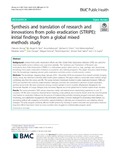Synthesis and translation of research and innovations from polio eradication (STRIPE): Initial findings from a global mixed methods study

View/
Date
2020-08-12Publisher
BMCAuthor
Alonge, OlakunleNeel, Abigail H.
Kalbarczyk, Anna
Peters, Michael A.
Mahendradhata, Yodi
Sarker, Malabika
Owoaje, Eme
Deressa, Wakgari
Kayembe, Patrick
Salehi, Ahmad Shah
Gupta, S. D.
Metadata
Show full item recordCitation
Alonge, O., Neel, A. H., Kalbarczyk, A., Peters, M. A., Mahendradhata, Y., Sarker, M., . . . Gupta, S. D. (2020). Synthesis and translation of research and innovations from polio eradication (STRIPE): Initial findings from a global mixed methods study. BMC Public Health, 20 doi:10.1186/s12889-020-09156-9Abstract
Background: Lessons from polio eradication efforts and the Global Polio Eradication Initiative (GPEI) are useful for
improving health service delivery and outcomes globally. The Synthesis and Translation of Research and
Innovations from Polio Eradication (STRIPE) is a multi-phase project which aims to map, package and disseminate
knowledge from polio eradication initiatives as academic and training programs. This paper discusses initial findings
from the knowledge mapping around polio eradication activities across a multi-country context.
Methods: The knowledge mapping phase (January 2018 – December 2019) encompassed four research activities (scoping
review, survey, key informant interviews (KIIs), health system analyses). This paper utilized a sequential mixed method design
combining data from the survey and KIIs. The survey included individuals involved in polio eradication between 1988 and
2019, and described the contexts, implementation strategies, intended and unintended outcomes of polio eradication
activities across levels. KIIs were conducted among a nested sample in seven countries (Afghanistan, Bangladesh, the
Democratic Republic of Congo, Ethiopia, India, Indonesia, Nigeria) and at the global level to further explore these domains.
Results: The survey generated 3955 unique responses, mainly sub-national actors representing experience in over 74
countries; 194 KIIs were conducted. External factors including social, political, and economic factors were the most frequently
cited barriers to eradication, followed by the process of implementing activities, including program execution, planning,
monitoring, and stakeholder engagement. Key informants described common strategies for addressing these barriers, e.g.
generating political will, engaging communities, capacity-building in planning and measurement, and adapting delivery
strategies. The polio program positively affected health systems by investing in system structures and governance, however,
long-term effects have been mixed as some countries have struggled to institutionalize program assets
Conclusion: Understanding the implementing context is critical for identifying threats and opportunities to global health
programs. Common implementation strategies emerged across countries; however, these strategies were only effective
where organizational and individual capacity were sufficient, and where strategies were appropriately tailored to the
sociopolitical context. To maximize gains, readiness assessments at different levels should predate future global health
programs and initiatives should consider system integration earlier to ensure program institutionalization and minimize
system distortions.
